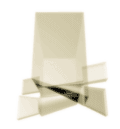Didier Fuiza Faustino (F)

Body building
performance vidéo, 1996
|
Didier Fuiza Faustino (F) |
 Body building performance vidéo, 1996 |
|
The central dimension of Didier Fiuza Faustino's line of thinking is the body. Not the body as a reference machine, but the body as a spatial component. For how is a space to be envisaged other than through its relationship with the body using it? So this involves taking the interactions between them into account, as well as the potential for action of each one, prior to any design. The area to be grasped is that of perception, as attested to by a series of works which challenge and question appearance, tactileness, and visual and physical instability. There is also the area of displacement, like choreographic containers where the itinerary is one of the component parts of the architecture introduced. Lastly, and logically enough, there is the area of the interstice and the infinitesimal. In considering the links between two worlds, is one not trying to grasp the intangible and the space-time factor that joins them together (or separates them)? Be it through his architectural projects or his explorations in the area of the visual arts - which reciprocally enhance one another - Didier Fiuza Faustino thus gets us to enter a physical dimension whose body is the atom, and whose architecture the interface. He examines our senses and their extensions in the constructed space at the risk of damaging them. Although precariousness is not really a condition of his work, his attachment to this concept prompts him to see his role and his projections in a state of impermanence. He is keen to be an agent provocateur rather than an emissary, and consequently wants above all to incorporate the whole dysfunction as a spatial production vehicle. In the research carried out, there is actually an underlying, political stance, which runs counter to order and tidiness. After flirting in his early phases with an ambient movement encouraging a certain "urban guerilla" tactic, this is now being sought in greater serenity, but there is still a definitive emphasis on "vicious actions", as is shown, for example, by the insidious distortions of the video In, trans, ex (1997) and the perverse reading of diplomacy for the Portuguese embassy project in Berlin (1998). It is also expressed in the critical reading of our patterns of behaviour and our relations with others and our environment. The accentuation of desire and exhibition, as well as of the inquisitive eye, rooted in everyone, thus informs projects such as Personal Billboard (1999). Intimacy is plumbed to its limits and challenged in relation to our contemporaneity, new methods of communication and expression surrounding us, and our emerging desires. The fact is that this context is the very context of the representational methods chosen, nevertheless, in an investigative approach, aimed at using the medium above all as an exploratory tool. The sort of immateriality emanating from the video and computer imagery presented contrasts with the (epi)dermic world built in tandem with the projects, but it paradoxically asserts the recurrent line of thin-king in all of Didier Fiuza Faustino's work, which prompts us to question our place and our role in this world, through our relationship to the space constructed in its immediacy and in its temporal structure. Marie-Hélène Fabre |
|
Alice's
House
Habitat concept-projet 1998/99 |
||
 |
This is a flexible membrane that connects two individual houses : two intersecting accesses merge as one by means of a "single-surface" footbridge. This space is conceived on several scales, which overlap with as many issues : -
Scale of the urban -
Scale of the building -
Scale of the individual |
|
|
Ambassade
du Portugal |
|
|
By refusing any cultural and aesthetic stereotype, the aim of this project is to propose a vision revealing the twofold dimension of diplomacy, at once the science of war and peace. Like an apparition, the building brushes against the troubled waters of history. The horizontal and vertical distribution of the elements of the programme is achieved in accordance with their function (chancellery/residence) and their degree of confidentiality (public/private/secret-defence) ; public and private elements [external or internal functioning] are thus exposed to the eye or, conversely, hidden. The visible part of the building, a three-headed Hydra looking down on the Goddess of Victory and the Reichstag, is embedded in the glasslike surface of a water garden to achieve its depth. its fragile base, a trapped space, is a point of stability and imbalance, a precarious mooring for a building with an unpredictable history. At once bunker and joystick, the embassy rises up as an impertinent form, destined to be altered : from angel blue to dirty khaki, its walls revolve, lending their transparency to time. After light, secrecy. |
|
|
Didier Fiuza Faustino (1968) 1995
– Diplômé de l'Ecole d'Architecture de Paris-Villemin Principaux projets et réalisations 1999
– "Urban Rhizome – hotel for the aliens" Roswell Housing Competition
(mentionné) ; "CCRG" Centre Culturel de Ribeira Grande, Açores
(concours) ; "Personal Billboard : an Urban Peep Show" Habitat concept
(projet) ; "Alice's House" Habitat concept (projet) Expositions récentes 1999
– "(A)casos (&) Materiais", CAPC (Centro de Artes Plasticas de
Coimbra) Bibliographie sélective de Didier Fiuza Faustino 1999
– "Architecte Borderline" Charles-Arthur Boyer, Art-Press n°245
; "Tra Body Art and Architecture" Francesco Careri, Spacio & Societa
n°85 ; "Tirer un Homme de sa Torpeur" et "Expressions" Parpaings
n°3, France |